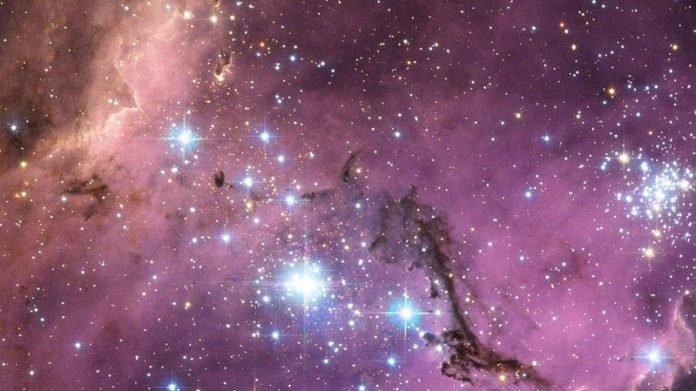
We live in a big-city galaxy.
The Milky Way is so big it has satellite galaxies that orbit it, just as the Moon orbits the Earth.
These arrangements tell us a great deal about the secrets of the universe—from how galaxies form to the mysterious nature of dark matter.
Two new studies have revealed more and more about these ‘groupie’ galaxies around the Milky Way, including evidence that large satellite galaxies can bring their own small satellites with them when they are sucked into orbit around the Milky Way.
Scientists have also extracted information about the halos of dark matter that surround these galaxies, as well as a prediction that our home galaxy should host an additional 100 or so very faint satellite galaxies awaiting discovery.
The research, co-led by University of Chicago Asst. Prof. Alex Drlica-Wagner in collaboration with scientists from SLAC National Accelerator Laboratory and the University of Wisconsin-Madison, was published in the April edition of the The Astrophysical Journal.
It relies heavily on data from the Dark Energy Survey, a groundbreaking effort to map the skies led by Fermi National Accelerator Laboratory and the University of Chicago.
“The Dark Energy Survey data gives us unprecedented sensitivity for the smallest, oldest, and most dark-matter-dominated galaxies,” said Drlica-Wagner.
“These faint galaxies can teach us a lot about how stars and galaxies form.”
Shining galaxies’ light on dark matter
Astronomers have long known the Milky Way has satellite galaxies—including the notable Large Magellanic Cloud, which can be observed with the naked eye in the southern hemisphere—but thanks to surveys with large telescopes, the list of known satellites has increased to about 60 over the last two decades.
These galaxies tell us much about the cosmos, including how much dark matter it takes to form a galaxy, how many satellite galaxies we should expect to find around the Milky Way, and whether galaxies can bring their own satellites into orbit around our own—a key prediction of the most popular model of dark matter. (The answer to that last question appears to be a resounding “yes.”)
“We wanted to rigorously answer the question: What is the faintest galaxy that our telescopes can detect?” Drlica-Wagner said.
To answer this question, they simulated over a million small satellite galaxies, embedded them into large astronomical data sets, and used their search algorithms to try to re-extract them. This allowed them to determine which galaxies could be detected and which were too faint for current telescopes.
They then combined this information with large numerical simulations of dark matter clustering to predict the total population of satellites around the Milky Way (including both those that we can see, and those that we cannot).
The result was a prediction that about 100 more galaxies remain to be discovered orbiting the Milky Way. If the “missing” 100 galaxies are discovered, this would help confirm the researchers’ model linking dark matter and galaxy formation.
“One of the most exciting things about this work is that we will be able to use our measurements of satellite galaxies to understand microscopic properties of dark matter,” Drlica-Wagner said.
The leading model for dark matter is that it’s a subatomic particle, like an electron or a proton, that was formed in the early universe.
If these particles of dark matter were very light, they could have had very high velocity, which would make it hard for dark matter to clump and form the galaxies that we see today.
Thus, by observing a large number of small galaxies, it is possible to put a lower limit on how much mass a dark matter particle could have, the scientists said.
“The particle nature of dark matter can have an observable consequences for the galaxies that we see,” said Drlica-Wagner.
The research was a collaborative effort within the Dark Energy Survey, led by the Milky Way Working Group, with substantial contributions from junior members including Sidney Mau, an undergraduate at UChicago; and Mitch McNanna, a graduate student at UW-Madison.



